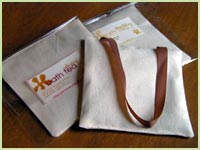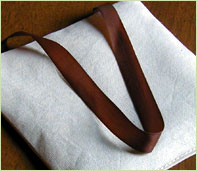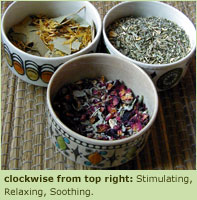
This is an old project that I originally posted to this site back in the early 2000’s. It was lost when we switched over to a new design, but I’ve brought it back in time for holiday gift-making. (p.s. the photos are small due to the original page design).
———————
This is a simple, but satisfying gift to make using herbs grown in your own garden. I’ve been making them for years and can fire off a large batch in one night. It’s the perfect gift for those who bathe — which is just about everyone.
-
What You Need:
- Cotton muslin or pre-made resealable tea bags (large size).
- Ribbon or string
- An assortment of herbs (see recipes below)
- Essential oils (optional)
- Rolled oats, epsom salts, sea salt (see below).
- Cellophane bags, cellophane roll, other packaging.
To make the bags you will first require some unbleached cotton muslin. Other cotton fabrics can be used, but I prefer this kind the most because it is dirt cheap ($2.00 and change for a yard or cheaper if you buy scraps from the ends bin) and has an open weave that holds in herbs yet allows their goodness to leach out easily into bathwater. In the past I have purchased ribbon (I’ll explain its use later), but this year I found some nice seam binding tape in earth tones for a very good price (29 cents a yard).
If you don’t want to sew you can purchase special large-sized, sealable tea bags made especially for this purpose. They are relatively cheap to buy and can be sealed with an iron. However, I guarantee you that even the most inexperienced sewer can make this. Keep in mind that it is going to be used a few times and eventually tossed into the compost heap. Precision is not necessary.
1. Start by cutting the fabric into squares. Any size is fine but I usually cut mine into 6″ squares because that is the thickness of my ruler and it’s faster.

2. Cut a 12″ length of ribbon or string. Butcher cord or just about any strong string you have on hand can be used. This will be used to hang the bag over the faucet so it must be strong enough to bear the weight of a bag of wet herbs.
3. Lay out a piece of fabric. Lay the string/ribbon on top in a u-shape with the U formed inside the square. The object is to sew the ribbon inside the bag so that when you turn the bag inside out, you can hold the ribbon like a handle. Place the other piece of fabric on top and secure with a few pins.
4. Sew around the square, making sure to leave a small opening to pour the herbs through. Turn your bag inside out through the hole, push out the corner and iron flat.
5. To fill the bag, take a piece of scrap paper and form a cone with it. Insert this into the hole and use it as a funnel through which to pour your herb mix.
6. Sew the seam shut with matching thread.
7. Herb bags can be packaged in cellophane to retain freshness and the potency of the smell longer. Or you can give as-is. Be sure to include a list of ingredients and instructions for use with each one. “Hang over faucet when filling tub. Hang to dry and reuse up to 3 times.”

Herb Mix Recipes:
Every year my recipes are different but they are always based on what I think are the three things people want out of a bath; to heal dry winter skin, to revitalize and stimulate their mind after a long, cold winter’s day, and to relax. As a result I mix my herbs accordingly. I often add a few additional ingredients including: rolled oats (coarsely ground in the blender first) for moisturizing and soothing, epsom salts for muscle relaxation and celtic sea salt (as opposed to table salt) for its healing properties. Powdered milk and citrus peel are also good additions. I have listed this year’s recipes below as well as a listing of other potential ingredients.
Please Note: When using herbs be sure your recipient doesn’t have an allergy. For example, chamomile is a common allergen to those with ragweed sensitivities (myself included). Also note that some herbs should not be given to pregnant women. Although you will not be drinking this ‘tea’, your skin is a semi-permeable membrane and anything that comes into contact with the skin will have an effect.
Soothing: Calendula petals, eucalyptus leaves, lemon balm, rolled oats, espsom salts, celtic sea salt.
Relaxing: Rose petals, lavender leaves, white sage, rolled oats, epsom salts, celtic sea salt.
Stimulating: Mint leaves, lemon grass, rolled oats, epsom salts, celtic sea salts, a dash of lemon grass and mint essential oils.
———————
Skin Softening/Healing:
· Chamomile
· Plantain
· Linden
· Rose Petals
· Ground Almonds
· Calendula flowers
· Chickweed
Stimulating:
· Mint (various)
· Lemon Grass
· Basil (various)
Relaxing:
· White Sage
· Calendula
· Rosemary
· Lavender
· Eucalyptus
· Rose Petals
· Thyme
· Beebalm
· Lemon Balm
· Chamomile
· Bay Leaf
· Jasmine flowers
Great idea – I’m going to try it!
I’ve been making my own lavender sachets for a couple of years that I throw into the dryer (I use unscented laundry products normally). When the scent runs out, I just cut open the bags, compost the insides, fill them back up with fresh lavender and sew the bags shut. It is a great way to use up fabric scraps. Also, bulk lavender is surprisingly cheap at my local health food store.
I am a big fan of urban and personal gardens and I love your blog. I think it is important to teach people about growing their own foods and making their own stuff! I have nominated you for the Versatile Blogger award! You can see your link here: http://culturalcomments.blogspot.com/2011/12/versatile-blogger-award.html
This would make a nice gift for someone! I will have to keep this in mind.